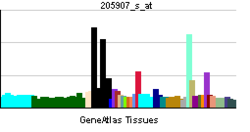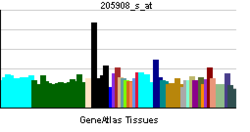- OMD (gene)
-
Osteomodulin Identifiers Symbols OMD; OSAD; SLRR2C External IDs MGI: 1350918 HomoloGene: 3677 GeneCards: OMD Gene Gene Ontology Molecular function • protein binding Cellular component • extracellular region
• proteinaceous extracellular matrixBiological process • cell adhesion Sources: Amigo / QuickGO RNA expression pattern 

More reference expression data Orthologs Species Human Mouse Entrez 4958 27047 Ensembl ENSG00000127083 ENSMUSG00000048368 UniProt Q99983 Q501L5 RefSeq (mRNA) NM_005014.2 NM_012050.2 RefSeq (protein) NP_005005.1 NP_036180.1 Location (UCSC) Chr 9:
95.18 – 95.19 MbChr 13:
49.68 – 49.69 MbPubMed search [1] [2] Osteomodulin is a protein that in humans is encoded by the OMD gene.[1]
References
Further reading
- Maruyama K, Sugano S (1994). "Oligo-capping: a simple method to replace the cap structure of eukaryotic mRNAs with oligoribonucleotides.". Gene 138 (1–2): 171–4. doi:10.1016/0378-1119(94)90802-8. PMID 8125298.
- Suzuki Y, Yoshitomo-Nakagawa K, Maruyama K, et al. (1997). "Construction and characterization of a full length-enriched and a 5'-end-enriched cDNA library". Gene 200 (1–2): 149–56. doi:10.1016/S0378-1119(97)00411-3. PMID 9373149.
- Wendel M, Sommarin Y, Heinegård D (1998). "Bone matrix proteins: isolation and characterization of a novel cell-binding keratan sulfate proteoglycan (osteoadherin) from bovine bone". J. Cell Biol. 141 (3): 839–47. doi:10.1083/jcb.141.3.839. PMC 2132750. PMID 9566981. http://www.pubmedcentral.nih.gov/articlerender.fcgi?tool=pmcentrez&artid=2132750.
- Buchaille R, Couble ML, Magloire H, Bleicher F (2000). "Expression of the small leucine-rich proteoglycan osteoadherin/osteomodulin in human dental pulp and developing rat teeth". Bone 27 (2): 265–70. doi:10.1016/S8756-3282(00)00310-0. PMID 10913920.
- Strausberg RL, Feingold EA, Grouse LH, et al. (2003). "Generation and initial analysis of more than 15,000 full-length human and mouse cDNA sequences". Proc. Natl. Acad. Sci. U.S.A. 99 (26): 16899–903. doi:10.1073/pnas.242603899. PMC 139241. PMID 12477932. http://www.pubmedcentral.nih.gov/articlerender.fcgi?tool=pmcentrez&artid=139241.
- Lucchini M, Romeas A, Couble ML, et al. (2003). "TGF beta 1 signaling and stimulation of osteoadherin in human odontoblasts in vitro". Connect. Tissue Res. 43 (2–3): 345–53. doi:10.1080/713713482. PMID 12489179.
- Clark HF, Gurney AL, Abaya E, et al. (2003). "The secreted protein discovery initiative (SPDI), a large-scale effort to identify novel human secreted and transmembrane proteins: a bioinformatics assessment". Genome Res. 13 (10): 2265–70. doi:10.1101/gr.1293003. PMC 403697. PMID 12975309. http://www.pubmedcentral.nih.gov/articlerender.fcgi?tool=pmcentrez&artid=403697.
- Couble ML, Bleicher F, Farges JC, et al. (2004). "Immunodetection of osteoadherin in murine tooth extracellular matrices". Histochem. Cell Biol. 121 (1): 47–53. doi:10.1007/s00418-003-0608-2. PMID 14673660.
- Gerhard DS, Wagner L, Feingold EA, et al. (2004). "The status, quality, and expansion of the NIH full-length cDNA project: the Mammalian Gene Collection (MGC)". Genome Res. 14 (10B): 2121–7. doi:10.1101/gr.2596504. PMC 528928. PMID 15489334. http://www.pubmedcentral.nih.gov/articlerender.fcgi?tool=pmcentrez&artid=528928.
Categories:- Human proteins
- Chromosome 9 gene stubs
Wikimedia Foundation. 2010.
